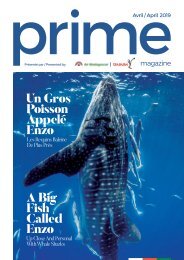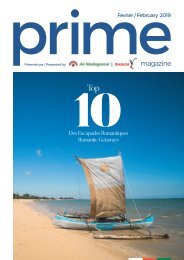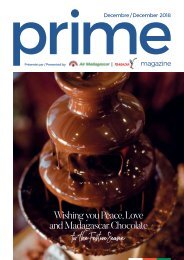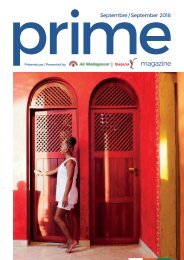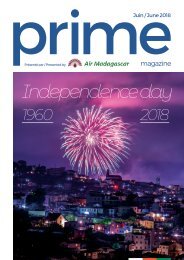PRIME MAG - AIR MAD - APRIL 2018 - SINGLE PAGES - all- LO-RES
- No tags were found...
You also want an ePaper? Increase the reach of your titles
YUMPU automatically turns print PDFs into web optimized ePapers that Google loves.
CULTURE<br />
TRADITION<br />
Fifagnotsafana<br />
Un bonjour qui n’est pas si simple<br />
A hello that is not so simple<br />
A la fois signe de politesse et de salutation, le<br />
Fifagnotsafana veut dire tout simplement «bonjour. » Il<br />
s’agit d’un comportement respectueux envers les parents<br />
et les aînés (Raiamandreny), loin de la désuétude.<br />
C’ est un « bonjour » qui renferme toute une culture. Parfois<br />
considéré comme un signe d’hypocrisie car on demande même<br />
si on connaît déjà la réponse, ce Soatoavina est une salutation<br />
qui prend des couleurs particulières selon les régions et les<br />
circonstances. Par exemple, pendant des visites funèbres, le<br />
famangiana manjo est une variante de Fifagnotsafana.<br />
C’ est un « bonjour » qui<br />
renferme toute une culture.<br />
Une coutume, une valeur<br />
Si un « bonjour » est avant tout un souhait de beau temps,<br />
de bonne humeur et de bon succès, un « Manao ahoana »<br />
veut tout dire. A l’origine, il s’agissait d’une question posée à<br />
un interlocuteur sur sa santé. Mais le sens actuel a bougé et<br />
aujourd’hui cette salutation implique de manière tacite, avant de<br />
demander des nouvelles à son interlocuteur, que l’on dise que<br />
l’on se porte bien soi-même. Dans les régions nord, nord-ouest<br />
et est de Madagascar, le Fifagnotsafana est exprimé clairement<br />
: « Mbola Tsara ! » « Salama e », des expressions qui signifient «<br />
je me porte bien » tandis que dans d’autres régions on préfèrera<br />
le « Akory aby » qui peut se traduire par « Comment <strong>all</strong>ez-vous ?<br />
». Des variantes qui ont toute leur importance...<br />
At the same time a sign of politeness and greeting,<br />
the Fifagnotsafana simply means “hello”. This is<br />
respectful behaviour towards parents and elders<br />
(Raiamandreny), far from obsolescence.<br />
It is a “hello” that contains a whole culture. Sometimes<br />
considered as a sign of hypocrisy because one asks even if<br />
one already knows the answer. This Soatoavina is a greeting<br />
which takes on a particular colour according to the region<br />
and the circumstance. For example, during funeral visits,<br />
the Famangiana Manjo is a variant of Fifagnotsafana.<br />
It is a “hello” that contains a<br />
whole culture.<br />
A custom, a value<br />
If a “hello” is above <strong>all</strong> a wish for good weather, good<br />
humour and every success, a “Manao ahoana” says it <strong>all</strong>.<br />
Origin<strong>all</strong>y, it was a question asked to a person about his<br />
health. But the current meaning has changed and today<br />
this greeting implies, in a tacit way, before asking for<br />
news to his interlocutor, that one says that one is doing<br />
well oneself. In the northern, north-western and eastern<br />
regions of Madagascar, Fifagnotsafana is clearly expressed:<br />
“Mbola Tsara!” “Salama e”, expressions that mean “I’m<br />
doing well” while in other areas we prefer “Akory aby”<br />
which can be translated as “How are you?” “. Variations that<br />
are important ...<br />
| 50 | Lire le magazine en ligne / Read the magazine online www.primemedia.international



